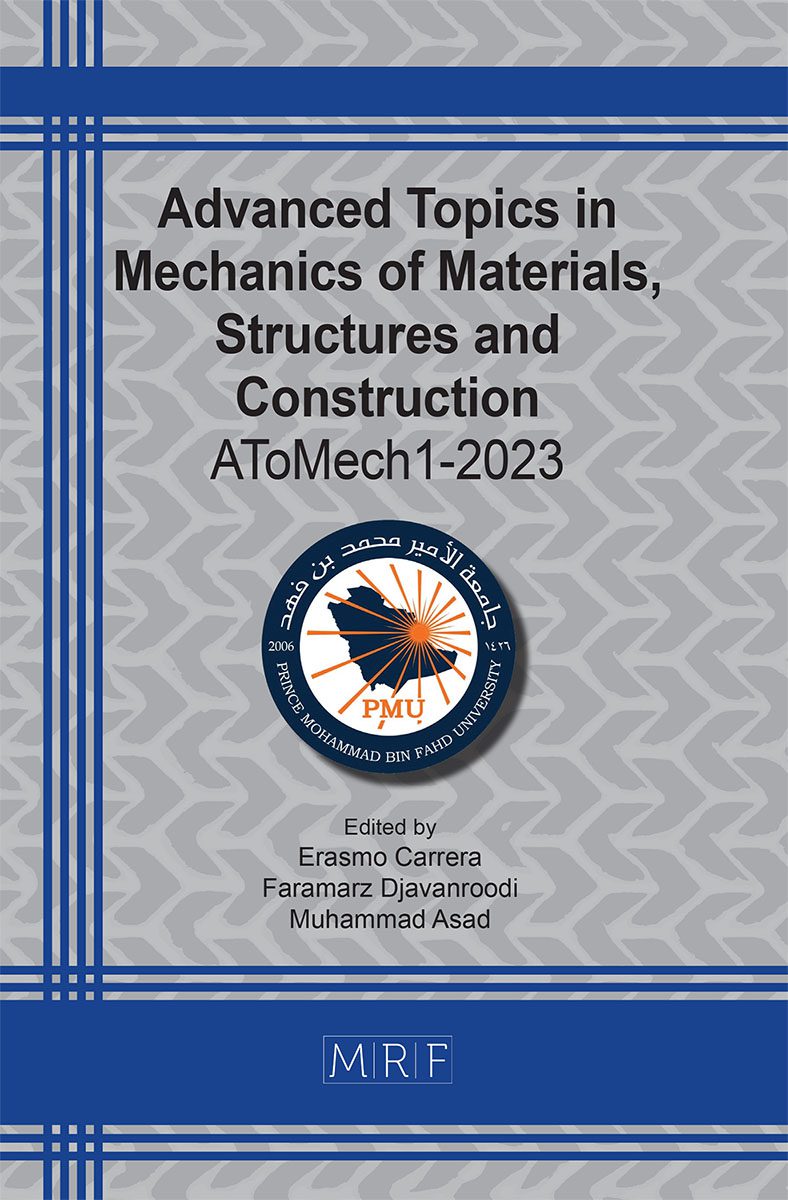Design of brake pads from economical materials
NOUARI Abdessamed, TAFRAOUI Ahmed, TAFRAOUI Salima, MALLEM Mohamed
download PDFAbstract. The aim of this work is to manufacture brake pads from a local ecological eco-material. The most commonly used materials in brake linings are asbestos, metals, and ceramics. However, asbestos releases hazardous gases upon application, making it carcinogenic. For the production of this eco-material, the powder molding technique is used. The brake pads were produced using dune sand as the base material, following the standard procedure used by manufacturers, with the aim of exploiting the chemical and physical characteristics of dune sand, which is abundant in the Algerian desert. This represents 70% of the brake pad production, in addition to 30% of polyester resins in compression molding. The properties examined were microstructure analysis, compression strength, roughness, temperature testing, and water absorption. The preliminary results show that sand can be used as a material in brake manufacturing. The results obtained in this work were compared to those of other studies and commercial brake pads and showed a close correlation, indicating that sand can be used in brake pad production.
Keywords
Design, Brake Pads, Molding, Lining, Materials
Published online 8/10/2023, 12 pages
Copyright © 2023 by the author(s)
Published under license by Materials Research Forum LLC., Millersville PA, USA
Citation: NOUARI Abdessamed, TAFRAOUI Ahmed, TAFRAOUI Salima, MALLEM Mohamed, Design of brake pads from economical materials, Materials Research Proceedings, Vol. 31, pp 538-549, 2023
DOI: https://doi.org/10.21741/9781644902592-56
The article was published as article 56 of the book Advanced Topics in Mechanics of Materials, Structures and Construction
![]() Content from this work may be used under the terms of the Creative Commons Attribution 3.0 license. Any further distribution of this work must maintain attribution to the author(s) and the title of the work, journal citation and DOI.
Content from this work may be used under the terms of the Creative Commons Attribution 3.0 license. Any further distribution of this work must maintain attribution to the author(s) and the title of the work, journal citation and DOI.
References
[1] W. Zhang, Y. Ren, S. Luo, S. Sun, S. Huang, A review of brake pad materials. Materials, 12 (7) (2019), 1070. https://doi.org/10.3390/ma12071070
[2] R. Banerjee, B. B. Saha, An overview on frictional behavior of automotive brake pad materials, Journal of the Mechanical Behavior of Materials, 26 (5-6), 263-276 (2017). https://doi.org/10.1515/jmbm-2016-0024
[3] B. Liu, X, Wang, Y. Zhu, X. Zhang, Friction and wear properties of brake pad materials, Tribology International, 118, 263-276 (2018). https://doi.org/10.1016/j
[4] M. Ziegler, P. Ebersbach, M. Priebe, T. Hecht, C. Schmiedel, K. Schubert, Investigation of the tribological behavior of different brake pad materials under dry and wet conditions, Wear, 398-399, 36-46, (2018). https://doi.org/10.1016/j
[5] X. Wu, Z. Wu, L. Gao, Tribological properties of friction materials under different braking conditions, A review. Friction, 7 (1), 1-20 (2019). https://doi.org/10.1007/s40544-018-0257-9
[6] Jiang, L., Wang, S., & Ma, S. (2022). Effect of pore structure on friction and wear properties of brake pads. Wear, 476-477, 203024. https://doi.org/10.1016/j. wear.2021
[7] Zou, Y., Zhu, X., Xu, C., & Yu, M. (2022). Tribological properties and wear mechanisms of non-asbestos organic brake pad materials containing SiC and CNTs. Tribology International, 164, 107035. https://doi.org/10.1016/j.triboint
[8] Zhan, Y., Li, W., Xie, Q., & Chen, L. (2022). Tribological properties of automotive brake pads based on mesocarbon microbeads (MCMBs) and Kevlar fiber. Materials Today Communications, 32, 101401. https://doi.org/10.1016/j.mtcomm
[9] Chen, Y., He, X., & Ding, L. (2022). Research on the wear behavior of automotive brake pads under complex working conditions. Wear, 478-479, 203098. https://doi.org/10.1016/j.wear.2021.203098
[10] Dong, X., Wu, H., Wu, J., & Chen, J. (2022). Effects of fiber length and fiber loading on the tribological properties of polyacrylonitrile-based brake friction materials. Polymer Composites, 43(2), 682-691. https://doi.org/10.1002/pc.26758
[11] A. Tafraoui, Contribution to the Valorization of Dune Sand from the Western Erg (Algeria) Application to new concretes; University of Toulouse, 2009.
[12] M. Collignon, Comprehension des mecanismes de degradation de disques de frein pour véhicule « POIDS LOURD » et definition de nouvelles solutions matériaux. thèse de doctorat, Ecole Doctorale SPI 072, Université Lille Nord-de-France N° ordre: 214.
[13] Z. Chang, P. Huang, Y. Hu, Study on the performance of automotive brake pads under different temperatures, Journal of Physics, Conference Series, 1944 (1), (2021), 012066, https://doi.org/10.1088/1742-6596/1944/1/012066.
[14] K. Hu, Y. Wang, X. Zhang, L. Liu, Effects of temperature and sliding speed on tribological properties of brake pad materials, Journal of Materials Engineering and Performance, 29 (10) (2020), 6575-6583. https://doi.org/10.1007/s11665-020-05277-w
[15] P. Wicker, Influence des garnitures de frein sur les sollicitations thermiques des disques TGV et conséquences sur les risques de fissuration, Ecole Centrale de Lille, (2009),
[16] T.P. Newcomb, Transient temperatures attained in disk brakes, British Journal of Applied Physics, vol. 10, 1959, pp. 339-340.
[17] R. Limpert; Brake design and safety, Editions Elsevier, 1992.
[18] P.K, Balguri, D G Harris Samuel, C. Indira, G. Dussa, T. Rao Penki, Udayabhaskararao Thumu, Tensile, Flexural and impact properties of properties of ultra small TiO2 nanotubes reinforced epoxy composites, Composites theory and practice, ISSN: 2084-6096, ISSN (online): 2299-128X, 2020.
[19] J. Huang, X. Zeng, Y. Chen, J. Zeng, X. Wang, Tribological performance of a brake pad system with a newly developed ceramic friction material, Tribology International, 147, (2020), 106313. https://doi.org/10.1016/j.triboint.2020.106313
[20] L. Jiang, S. Wang, S. Ma, Tribological properties of porous brake pad materials with different pore structures, Tribology International, 150, (2020), 106397. https://doi.org/10.1016/j.triboint.2020.106397
[21] X. Wu, Y. Li, B. Li, W. Li, Effects of water absorption on the tribological behaviour of automotive brake pad materials. Wear, 476-477, (2021), 203025. https://doi.org/10.1016/j.wear. 2021. 203025
[22] P. Szymański, D. Czarnecka-Komorowska, K. Gawdzińska, A. Trubas, E. Kostecka. A REVIEW OF COMPOSITE MATERIALS USED IN BRAKE DISC PADMANUFACTURING PROCESS, Composites theory and practice, ISSN: 2084-6096, ISSN (online): 2299-128X, 2020.
[23] M. Maniana, A. Azim, F. Erchiqui, A. Tajamouati, Etude du transfert thermique dans un frein à disque, Laboratoire CAMEL, UQAT, Canada.































